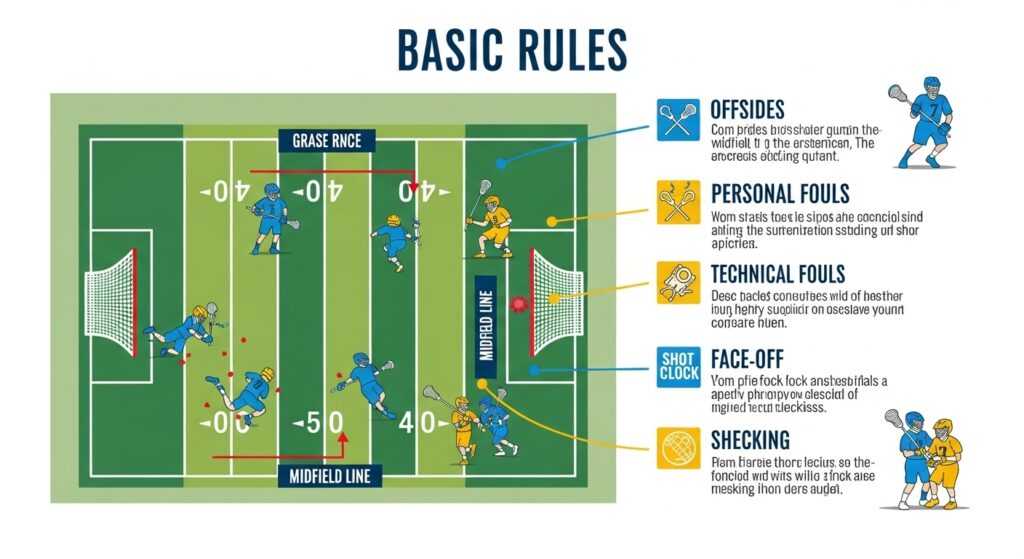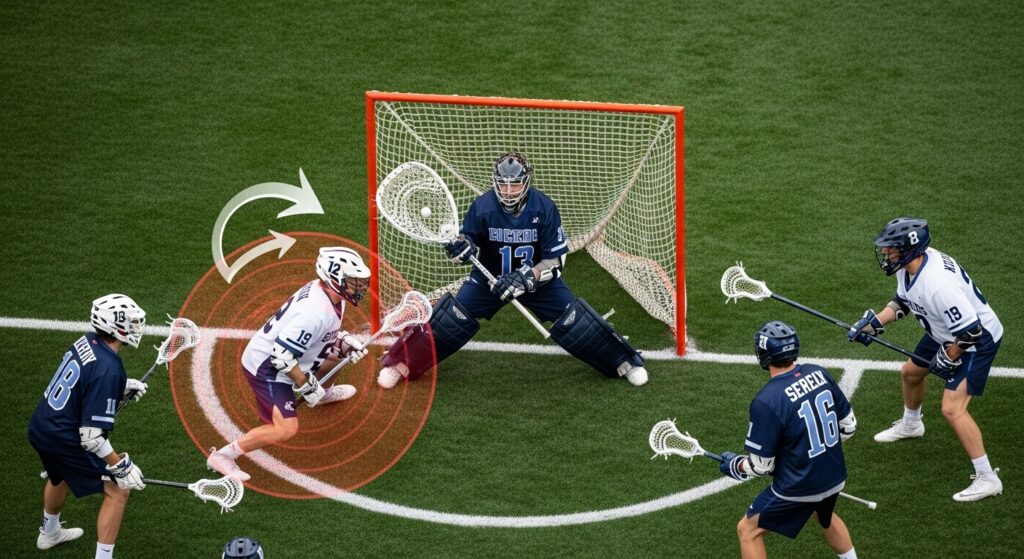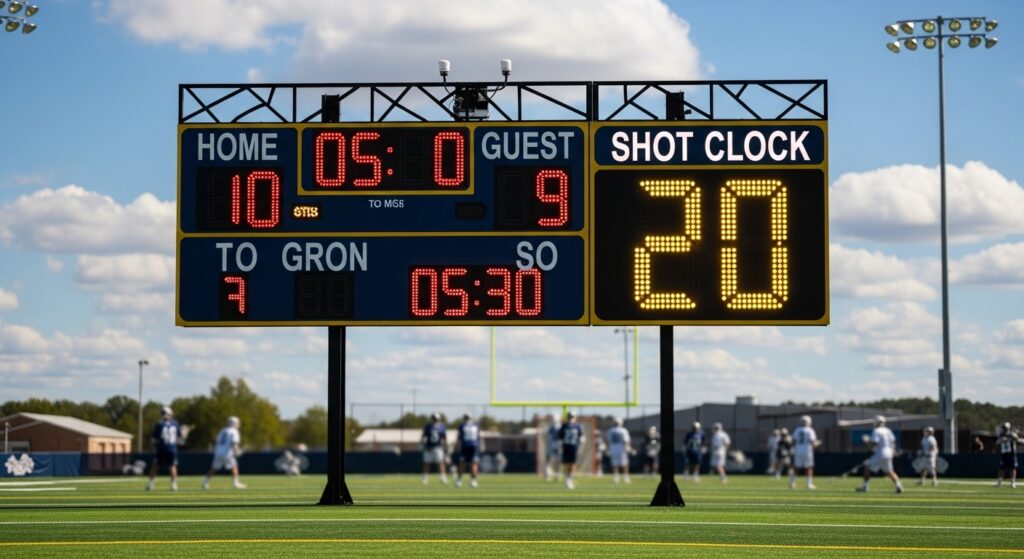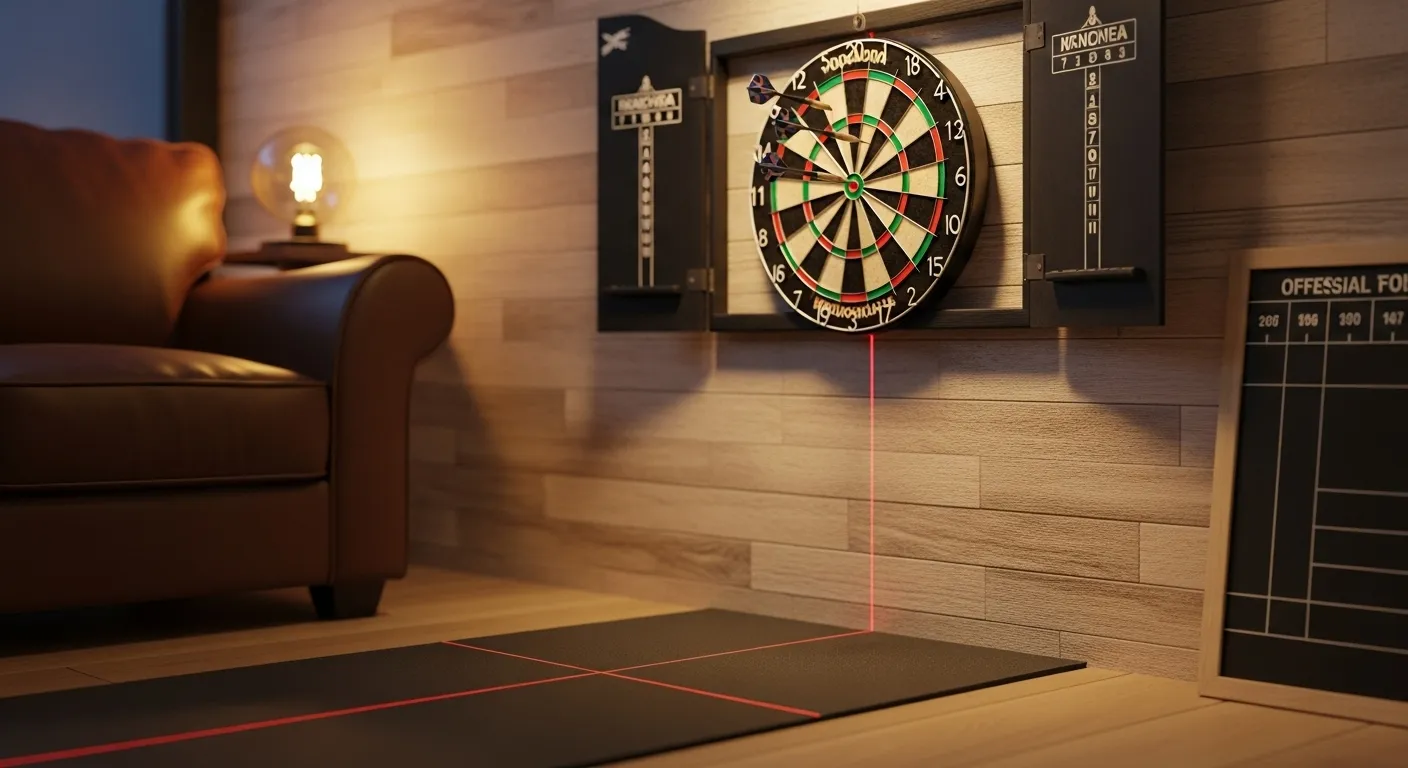Lacrosse rules. That phrase alone makes some beginners panic because the game looks chaotic at first glance. The sticks, the speed, the constant whistles—it can feel like you’re watching a mash-up of hockey and basketball on grass. Except when you’re the one playing, you realise most penalties and turnovers happen because people forget the basic rules. Not the complicated ones. The small but critical ones.
If you’re new to Lacrosse rules maybe you just joined a high school team, perhaps you’re a parent trying to keep up, or maybe you’re a fan dipping your toes in—it helps to know the rules that actually trip people up. Not just the “how many players on the field” stuff, but the overlooked details refs blow their whistles for constantly.
This isn’t an official handbook. It’s more like a field note collection: the kind of stuff players, coaches, and even refs mumble about after games.
Rule #1 – Offside (The Classic Beginner Mistake)
The most common, most frustrating call for new players: offside.
Here’s the gist: under lacrosse rules, you can’t have too many players across one side of the field. The game forces balance.
Men’s lacrosse: at least three players must stay in the offensive half, and 4 in the defensive half (goalie included).
Women’s lacrosse: the numbers shift slightly, but the concept’s the same—field balance is required.
Why this matters: It’s easy to get caught up chasing the ball. You push forward, forget to look behind, and suddenly the whistle blows.
Quick Offside Breakdown Table
| Situation | Men’s Game | Women’s Game |
|---|---|---|
| Players required offense | 3 | 4 |
| Players required defense | 4 (goalie incl.) | 4 (goalie incl.) |

Rule #2 – The Crease (That Forbidden Circle)
Every goal has a circle around it, called the crease. According to lacrosse rules, attackers aren’t allowed inside. Step on the line, even accidentally, and the ball’s turned over.
Goalies basically own the crease. They can step out, but if attackers charge inside, it’s an automatic violation. Defenders may enter the crease, but can’t hold possession there under standard lacrosse rules.
A lot of rookies forget their feet matter. Even a toe brushing that line? Whistle.

Rule #3 – Illegal Body Checks
Lacrosse is physical, but not a free-for-all. Under standard lacrosse rules, body checks have strict limits.
Legal checks: body-to-body, above the waist, from the front or side.
Illegal checks: from behind, to the head, below the waist, or late after a pass.
It’s the timing that throws new players. You think you got a clean hit, but if the ball’s already gone? Too late.
Refs call this a lot more than you’d expect in both men’s and women’s lacrosse rules.
Rule #4 – Shot Clock and Possession
Not every level enforces a shot clock, but if you’re playing college men’s lacrosse, you’ll deal with it. In fact, this is one of those lacrosse rules that changes depending on the league.
NCAA men’s: 60 seconds to get a shot on the cage after possession.
High school: sometimes no shot clock, but refs can call “stalling” if you delay too much.
Possession also confuses people. Ball goes out of bounds after a shot? Closest player to it wins the ball—not necessarily the team who shot it. That’s unique compared to most sports and a detail in lacrosse rules that beginners often miss.

Rule #5 – Cross-Check Penalties
Beginners often push with the stick shaft pressed against the opponent’s back or chest. That’s called cross-checking, and it’s illegal. Developing better 1v1 ball control skills (like in this soccer dribbling plan) can actually help players rely less on fouls and more on clean defense.
Instead, you’re supposed to use controlled positioning and pokes. It feels awkward at first, especially if you come from hockey. But if the stick is across the torso? Expect the whistle.
Rule #6 – Faceoff Violations
Faceoffs look simple but are full of tiny details.
Most common mistakes:
- Moving before the whistle.
- Holding the clamp too long.
- Not setting the stick properly.
Table: Common Faceoff Violations
| Violation | Result |
|---|---|
| Early movement | Possession loss |
| Clamp held too long | Violation called |
| Stick incorrectly placed | Violation called |
Multiple faceoff violations by one team = automatic possession awarded to the other.

Rule #7 – Slashing
Swing your stick wildly? That’s slashing. Doesn’t matter if you claim you were “going for the stick.” If you connect with the body, helmet, or gloves, it’s a penalty under standard lacrosse rules.
It’s subjective, too. Some refs call tight, others let borderline contact slide. Which makes it tricky for beginners who are still learning the basics of lacrosse rules and stick control.
Rule #8 – Holding and Interference
Holding = grabbing a jersey, a stick, or even hands.
Interference = messing with a player who doesn’t even have the ball.
Both are easy fouls to avoid, yet new players do them constantly. Mostly out of panic, trying to stop fast attackers. These are simple violations spelled out clearly in lacrosse rules, but they still trip up beginners who forget how strict the game can be about player contact.
Rule #9 – Shooting Space (Women’s Lacrosse Only)
Unique to women’s lacrosse. Defenders can’t just jump into the direct path of a shooter, because it’s unsafe. Getting hit with a ball traveling at 70+ mph isn’t fun.
So, if you step into that lane without proper position? Whistle, free position awarded. Good defensive positioning here is kind of like practicing shooting drills in soccer—the goal is to stay safe while still keeping pressure on the attacker.
So, if you step into that lane without proper position? Whistle, free position awarded.
Rule #10 – Substitution Mistakes
Subbing in lacrosse is like hockey—you do it on the fly. But you must enter and exit through the designated box.
Beginners often forget, rush the line, or cause too many players to be on the field. Refs don’t miss this one.

Quick Rule Recap
| Rule | Common Mistake |
|---|---|
| Offside | Crossing too soon |
| Crease violation | Stepping inside |
| Illegal body check | Hitting from behind |
| Shot clock | Forgetting to shoot |
| Cross-check | Stick across opponent’s back |
| Faceoff violation | Moving early or bad setup |
| Slashing | Wild stick swing |
| Holding/Interference | Grabbing or blocking illegally |
| Shooting space (women) | Blocking shooting lane |
| Substitution error | Too many men on the field |
Beyond the Top 10 (Stuff You’ll Hear Refs Yell About)
- Loose-ball push: Shoving someone while neither has possession.
- Ward: Using your free hand to block defenders illegally.
- Goalie interference: You can’t touch or disrupt the goalie in the crease.
These don’t happen as often as the top ten, but they show up enough that you’ll hear them often.
Penalty Times (Handy Reference)
| Foul Type | Typical Penalty Time |
|---|---|
| Offside | 30 seconds |
| Crease violation | Turnover |
| Illegal body check | 1 minute |
| Cross-check | 1 minute |
| Slashing | 1–2 minutes |
| Holding / Interference | 30 seconds |
| Substitution error | 30 seconds |
FAQs (From Google’s People Also Ask)
Q1. What are the most important rules in lacrosse?
The main ones: offside, crease violations, checking rules, possession/shot clock, and substitutions.
Q2. Can you hit people in lacrosse?
Yes, but only legally. Hits must be above the waist, from the front or side, never to the head or back.
Q3. How long can you hold the ball in lacrosse?
With a shot clock (college men’s), you have 60 seconds to shoot. Without one (like some high school levels), refs may call stalling.
Q4. What counts as slashing in lacrosse?
Any reckless stick swing that connects with the body, head, or gloves. Even if you meant to hit the stick.
Q5. Is lacrosse hard for beginners?
Yes and no. Stick skills take time, but once you know the flow and rules, it feels natural.

I’m Daniel Moore, and I live for the thrill of the game. Get energetic live commentary, detailed match analysis, data-backed betting predictions, and official team rankings right here.



